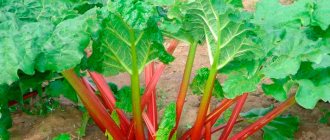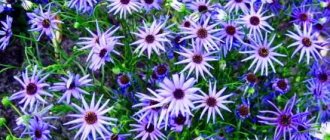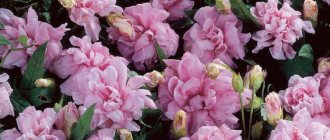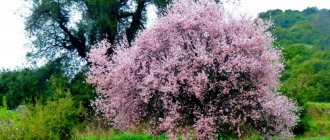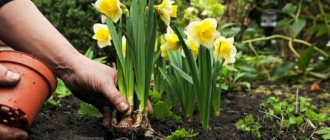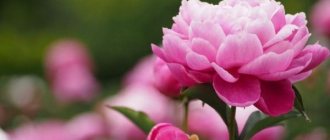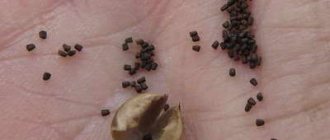Description
Rhubarb, although classified as a vegetable, is a large-leaved herb. Large leaves on long petioles are collected in a rosette. The leaf blades are usually rounded with smooth or corrugated edges. Some species have dissected and carved leaves. The plant can grow 2-4 m in height. The root system is represented by a rhizome. It is fleshy, branched and rod-shaped. Penetrates deeply into the soil - up to 1.5 m deep.
When eaten fresh, “rhubarb sticks” are eaten dipped in sugar, but they make compotes, jelly, jams and fillings much tastier. They go perfectly with gooseberries.
The crop blooms more often in the second year, but sometimes it throws out the inflorescence only in the third or fourth year. Chalk flowers are collected in panicles. They are often pale green in color, less often they have a reddish or pinkish tint. The flowers are bisexual, that is, both female and male. However, it also happens that due to underdevelopment, flowers of the same sex are formed. After pollination, fruits are formed. These are triangular achenes with brown wings. Ripe seeds quickly fall off. Germination remains up to 4 years.
What can you cook with rhubarb?
And now why rhubarb is needed on the plot. Since, let us recall, the plant contains a large amount of oxalic acid, the petioles are not recommended to be included in food raw. But you can prepare a lot of dishes with the addition of rhubarb (you can even pickle it). Here are the most popular ones.
Rhubarb soup
You will need: 500 g rhubarb, 120 g sugar, 25 g potato starch, 1 liter of water, sour cream and salt to taste.
Preparation. Peel the rhubarb stems, rinse well and dry. Chop as desired and boil in salted water. Then wipe, add the broth, leaving about half a glass, and stir, put on low heat. Cool the remaining broth and dissolve the starch in it. Put the broth back on the fire and gradually pour in the starch, without bringing the soup to a boil. Remove from heat, add salt and sour cream to taste.
Rhubarb Pie
You will need: 2 bunches of rhubarb, 1 tbsp. butter, 6-8 tbsp. flour, 1-2 cups sugar, 2 sheets of ready-made shortcrust pastry, vegetable oil for greasing the pan.
Preparation. Mix flour and sugar. Add the chopped rhubarb and stir again. Roll out one sheet of dough and place it in a pan greased with vegetable oil, forming sides. Top with rhubarb filling and sliced butter. Roll out another sheet of dough, cut into strips and lay out a weave of them on top of the pie. Bake it in an oven preheated to 220 degrees for 10 minutes, then reduce the temperature to 175 degrees and bake for another 30 minutes.
Rhubarb jelly
You will need: 400 g rhubarb, 120 g sugar, 30 g potato starch, 1 liter of water.
Preparation. Peel the rhubarb, rinse, dry a little, add hot water and boil until soft. Strain the broth, mix some of it with sugar, then put it back on the fire. Dissolve starch in the remaining liquid. When the rhubarb compote comes to a boil, add the starch broth to it. Stirring, bring the mixture to a boil and remove from heat.
Growing from seeds
Growing rhubarb from seeds consists of several stages.
Obtaining seed material
Seeds are collected from a plant that is older than 4 years. To do this, leave one peduncle on the bush. When ripe, they quickly fall off, so as not to be left without them, the browned peduncle with unripe seeds is cut off and left in a dry, dark and well-ventilated place until the seeds are completely ripened.
Before sowing seeds, it is necessary to determine the location and prepare the soil for the plant.
Site selection and soil preparation
Rhubarb is a hardy crop that grows in almost all soils. However, it develops and grows well on fertile and light soils, which need to be deeply cultivated up to 40 cm in depth.
Places with perennial weeds - wheatgrass, burdock or thistle are not suitable for it. It is better to choose a site on a southern or southeastern slope, where the depth of groundwater does not exceed 1.5 m. The plant tolerates shade, but produces an early harvest in illuminated areas.
It can grow in one place for up to 15 years, but it should be borne in mind that after 10 years its productivity drops noticeably. Experienced gardeners advise replanting the crop after 5 years, after dividing it.
Soil for crops is prepared in the fall, mixing it with compost or humus. Be sure to add potassium and phosphorus fertilizers. If the soil is acidic, it is limed. In the spring, the area is dug up again and ammonium nitrate or other nitrogen-containing fertilizers are applied at the same time.
Seed preparation
To prepare the seeds, perform the following procedures:
- Soak. Before sowing, they are soaked in warm water for 8-10 hours or left in water at room temperature for 3 days. Seeds floating on the surface of the water are thrown away, since shoots cannot be expected from them.
- Disinfection. Then, in order to reduce the risk of developing diseases in the future, they are left in a solution of potassium permanganate for 1 hour.
- Germination . The seeds are transferred to burlap and kept there until they hatch. The sprouted seeds are dried.
- Sowing. Seeds are planted in moist soil to a depth of 2-3 cm, the distance between rows is 70 cm.
They are sown in open ground in early April, but since the seeds germinate at a lower temperature of 2-3°C, some gardeners practice sowing into frozen soil in pre-prepared beds.
Choosing a place to plant rhubarb
Rhubarb is a perennial plant that can grow in the same place for 15 years or more.
. Over time, the yield decreases, the bushes may require rejuvenation, for which they are transplanted to a new place and fed with organic and mineral fertilizers. Rhubarb is a frost-resistant plant, so it easily tolerates even harsh winters with little snow.
Rhubarb can successfully grow near fences or in the shade of trees, but the earliest and most abundant harvest can be obtained only when the bushes are well illuminated by the sun. The gardener needs to remember that these are powerful, tall plants that seriously deplete the soil around them, so you will need to regularly feed rhubarb plantings, which will be the key to getting an excellent harvest.
Useful video about rhubarb
It is enough for a gardener to plant 5-6 bushes on a plot to provide his family with valuable and tasty greens for the whole year. The harvested crop can be stored fresh for many months in the refrigerator; various leaves are also made from the tender leaves, jam is made, and dried petioles are used as an excellent seasoning and addition to meat and fish dishes.
Seedling method
Seeds are prepared before sowing in the same way as when planted in open ground. Sprouted seeds are planted in peat pots or plastic containers filled with universal soil for seedlings. The rules are followed: one pot - one seed. The containers are placed in a warm place where the sun's rays do not reach and covered with polyethylene, thus creating a microclimate.
The soil is regularly sprayed with water from a spray bottle, keeping it moist, and ventilated. After germination, the polyethylene is removed, and the pots are moved to a bright place - on the windowsill, and the temperature is maintained at around 20-22°C. By the end of summer, the seedlings reach a height of 30 cm, have at least 3-4 leaves and are ready to be transplanted to a permanent place in the open ground.
The wells are prepared in advance. Dig holes measuring 30 by 30 cm, pour humus into them and add mineral fertilizers. Then water well and leave alone for several days. The seedlings are transplanted by transshipment without disturbing the earthen coma.
If peat cups were used to grow seedlings, then the plants in the hole are placed directly into them. The root collar should be buried 2-3 cm to prevent it from being exposed when snow melts or when watering. Then the soil is compacted and mulched with peat. Transplantation is carried out in cloudy weather.
Seedling care
In open ground, three weeks after emergence, they are thinned out to a distance of 15-20 cm from each other. Then this procedure is repeated later, but 50 cm is left between them.
The seedlings are fed a week later with a solution of slurry, and after 3 weeks mineral fertilizers are added - urea, superphosphate and potassium chloride.
If the plant produces arrows, they must be removed, otherwise the plant will become depleted.
Propagation by dividing rhizomes
Only 5-year-old bushes are suitable for this method. They must be carefully cut into pieces with a sharp knife. Each should have 1-2 large buds and a well-developed root system. Preference should be given to those “eyes” that are located on the periphery. Plants obtained from central buds more often throw out flower stalks.
Rhizomes are planted in late August or spring. They are planted in holes 30 by 30 cm, into which compost and garden soil are poured. They are planted level with the ground, keeping a distance of 70 cm between them. The soil is compacted and watered. The buds are sprinkled with humus in a layer of 1.5-2 cm.
You can propagate the crop using rhizomes without buds, but then you should not expect rapid regrowth of the petioles. In this situation, the development of the plant will be very slow.
Care
The plant is demanding of soil moisture, but it does not like waterlogging. Drought is also not good for it, since the lack of moisture affects the size and taste of the petioles. When there is heat and lack of water, they are stunted in growth. Thin, short petioles with a bitter taste will appear on the table. Regular watering, on the contrary, increases the yield and quality of the vegetable.
Fertilizers are applied in early spring - either mineral or organic combined with an ash solution. Once every three years, humus is added between the rows.
Rhubarb is not afraid of frost. In winter it tolerates severe cold down to -30°C. In spring it can withstand frosts down to -10°C, but provided that the buds do not have time to “wake up”. However, a comfortable temperature for it is 16-20°C.
In the second or third year, rhubarb begins to produce flower stalks. They must be ruthlessly removed, otherwise leaf regrowth will be greatly slowed down.
Cultivated rhubarb
Rhubarb is best grown in slightly acidic, loamy soils rich in humus. It is not afraid of light shading, so it is suitable for both sunny and partial shade in the garden. Only a young plant needs an abundance of sunlight. It is undesirable to plant rhubarb in lowlands, where prolonged flooding is possible; the rhizome rots. In hot, dry weather, rhubarb bushes must be watered, otherwise the leaves will develop poorly and the petioles will become coarse so that they cannot be used.
Varieties
There are several varieties of rhubarb known in the world, but in the post-Soviet space this vegetable is grown without regard to grade. This absolutely does not prevent rhubarb from occupying a prominent place in the summer cottages and garden plots of residents of Russia, Ukraine and Belarus.
- With red petioles: “Cherry Red”, “Canada Red”, “MacDonald”, “Crimson Red”, “Ruby Valentine”.
- With pinkish-green petioles: "Baker's All Season", "Appleton's Forcing", "Victoria".
- With green petioles: “Stubborn”, “Tukumsky 5”, “Moskovsky 42”, “Gigantic”, “Robin”, “Ogre 13”, “Large-petiolate”.
Despite the fact that rhubarb can hardly be called an ornamental plant, thanks to its wide wavy leaves, it is often used by landscape designers to decorate a site or garden. A massive bush during flowering attracts the eye. Considering that in early spring there is not much other greenery and flowers in the garden, rhubarb takes its rightful place, decorating the garden and at the same time providing petioles for the table.
Features of growing rhubarb by year
Rhubarb has some features of growing by year:
- In the first year of planting, the stalks are not harvested. We need to let the plant grow well. During this period, they monitor the moisture of the soil and water it in a timely manner - the soil should not dry out, but you should not flood the plant either. Be sure to loosen the top layer of soil and remove weeds on time. In autumn, dead leaves are removed and the rosette itself is hilled up.
- In the spring of the second year, as soon as the snow has melted and the soil has warmed up, the top layer of soil is loosened and fertilizers are applied. Further care is no different from the previous year. Petioles that have grown to 30 cm can be broken off.
- Care in the third and subsequent years is no different. However, by this time the plant has already grown sufficiently, and the crop can be harvested several times during the growing season.
Where to buy and how to choose
Fresh rhubarb stems can be purchased at markets in most parts of the country from April to July.
If you are growing it in your garden, pluck the petiole by grasping it at the base while pulling and twisting it. Immediately separate the stem from the leaf part. Rhubarb greens contain oxalic acid, as well as poisonous glycosides.
Read about growing rhubarb in your summer cottage in this publication from rblogs.ru.
When shopping at the market, look for fresh, firm, crisp, bright red stems. Do not take dull, flaccid petioles with spots on the surface.
Diseases and pests
Many gardeners note that rhubarb is rarely attacked by insect pests and is resistant to diseases. Only weakened plants, in the care of which agrotechnical errors were made, can be at risk.
If we talk about diseases, they are usually of fungal origin. Various pathogenic fungi settle on rhubarb leaves and petioles.
Among the most common plant damage are:
- Gray rot . The development of gray rot is provoked by excessive watering. Young leaves are covered with gray fluff, which then spreads to the rest of the plant.
- Downy mildew or downy mildew - brown spots with a purple or white tint appear on the leaves on the underside and petioles. Sources of infection are plant debris or soil. For preventative purposes, before sowing, thoroughly clean the area of plant debris and spill it with a solution of potassium permanganate.
- Cercospora - leaves and petioles become covered with brown spots with a velvety coating. Beetroot is most susceptible to this disease, so these crops should not be planted nearby. In addition, with such close proximity, the root crop pest, the beet flea beetle, can also spread to rhubarb.
Treatment of fungal diseases, and all of the above diseases belong specifically to this type, consists of removing the damaged parts of the plant and treating it with 1% Bordeaux mixture.
The following pests can settle on rhubarb:
- weevil;
- bug;
- moth;
- aphid;
- beet flea beetle.
Aphids settle in numerous colonies on the reverse side of the leaf; it is not difficult to notice them. They suck the juice out of the rhubarb and lead to its death. A folk remedy that has worked well against it is treating the plant with a solution of wood ash and laundry soap or an infusion of garlic and soap.
The rhubarb weevil eats leaf blades and lays eggs in the petioles. Spraying plants with infusion of tobacco or mustard will help scare off adults.
If rhubarb is adjacent to cabbage or potatoes, it may be attacked by cutworm larvae. They live inside the petiole and feed on its pulp. It is necessary to remove all weeds near the plants and dig up the affected rosettes. To prevent the butterfly from laying eggs on the plants, they are treated with an infusion of tomato tops or wormwood. The smell will keep cutworms away from your area.
If there are a large number of pests on plants, there is no need to waste time. They must be treated with suitable insecticides. But in this case, the collection of petioles is stopped, since harmful substances accumulate in parts of the plants.
Properties of rhubarb - harm and benefit
Useful properties of rhubarb
Rhubarb petioles and its young leaves, which have a refreshing sour taste due to the presence of citric and malic acid in them, are eaten. The petioles also contain carbohydrates, vitamins C, PP, group B, fiber, pectins, carotene, magnesium salts, calcium, potassium and phosphorus. Eating rhubarb has a positive effect on the functioning of the intestines and kidneys. It is indicated for people with low acidity and is effective in the treatment of purulent formations, wounds, burns, colds, sinusitis and runny nose.
Rhubarb contains biologically active substances that prevent the development of cardiovascular diseases, strengthen the myocardial muscle, cure heart failure and significantly reduce the risk of stroke.
The medicinal properties of rhubarb have been known for a long time. Rhizome preparations have greater healing properties, which in large doses act as a laxative, and in small doses as an astringent. Rhizome preparations are prescribed for constipation, gas accumulation, and intestinal atony. However, people suffering from hemorrhoids should not take them. In small doses, the rhizome preparation is taken as an antidiarrheal (at a dosage of 0.2 to 0.8 g) and choleretic (from 0.1 to 0.5 g) agent. The rhizome preparation in small doses is prescribed for tuberculosis and anemia as a general tonic. For the same purpose, you can drink half a glass of rhubarb juice 3 times a day. Externally, rhubarb is used to get rid of white spots on the skin caused by vitiligo.
Laxatives and rhubarb teas are popular in folk medicine. The plant is also consumed in the form of powder, syrup, infusion, decoction or tincture in alcohol or wine. At the pharmacy you can buy rhubarb in the form of powder, tablets, extract or alcohol tincture.
Rhubarb - contraindications
Since rhubarb contains acids that promote the formation of kidney and bladder stones, it is better for those suffering from cholelithiasis and urolithiasis to avoid rhubarb. It is not recommended to use rhubarb for patients with gastritis with high acidity and pancreatitis, and since rhubarb thins the blood, it is contraindicated for hemorrhoids and bleeding.
Harvesting
The first petioles are broken off in the spring, when they have grown at least 30 centimeters in length. Why is it recommended to break them off by hand and not cut them? The thing is that when cutting, a stump remains, which begins to quickly rot. After harvesting, be sure to leave 2-3 leaves or more on the plant to prevent depletion of the rhizome.
The most useful are the petioles that grew at a temperature not exceeding +17°C. They, compared to petioles growing at higher temperatures, contain a minimal concentration of oxalic acid. This acid in large doses is harmful to the body, as it forms poorly soluble salts that do not allow calcium to be fully absorbed. The largest harvest is harvested from 5-6 year old specimens.
Chemical composition and calorie content
Nutritional value per 100 g of fresh rhubarb (Rheum rhabarbarum):
- Calories: 21 cal.
- Carbohydrates: 4.54 g
- Dietary fiber: 1.8 g
- Fat: 0.20 g
- Protein: 0.90 g
| Vitamins and minerals | Quantity | % of daily value |
| Folates | 7 mcg | 2 |
| Niacin | 0.300 mg | 2 |
| Pantothenic acid | 0.085 mg | 1,5 |
| Pyridoxine | 0,024 | 2 |
| Riboflavin | 0,030 | 2 |
| Thiamine | 0,020 | 2 |
| Vitamin A | 102 ME | 3,2 |
| Vitamin C | 8 mg | 12 |
| Vitamin E | 0.27 mg | 2 |
| Vitamin K | 29.3 mcg | 24 |
| Sodium | 4 mg | 0,5 |
| Potassium | 288 mg | 24 |
| Calcium | 86 mg | 8,5 |
| Copper | 0.021 mg | 2 |
| Iron | 0.22 mg | 3 |
| Magnesium | 12 mg | 3 |
| Manganese | 0.196 mg | 8,5 |
| Phosphorus | 14 mg | 2 |
| Selenium | 1.1 mcg | 2 |
| Zinc | 0.10 mg | 1 |
| Beta carotene | 61 mcg | — |
| Lutein-zeaxanthin | 170 mcg | — |
The stems contain several B vitamins: folate, riboflavin, niacin, vitamin B-6 (pyridoxine), thiamine and pantothenic acid.
Red petioles contain more vitamin A than green varieties. They also contain small amounts of polyphenolic flavonoid compounds such as beta-carotene, zeaxanthin and lutein. In the human body, they are converted into vitamin A, a powerful natural antioxidant that maintains the integrity of the skin and mucous membranes. It is also important for healthy vision. Natural foods rich in vitamin A protect against lung and oral cancer.
Adequate levels of vitamin K in the diet help limit damage to neurons in the brain, and thus help in the prevention and treatment of Alzheimer's disease.
The petioles also contain beneficial minerals such as iron, copper, calcium, potassium and phosphorus. However, most of these minerals are not absorbed by the body because they are converted to an insoluble form by oxalic acid, which is then excreted from the body.
Rhubarb contains more calcium than the same amount of milk, but in a form that the body cannot easily absorb.
Reviews from vegetable growers
Gardeners who grow rhubarb in their gardens confirm the winter hardiness of the plant. Also, many note that it is immune to disease and is little susceptible to insect attack. But, on the other hand, it suffers from drought, which immediately affects the quality of the petioles, and is moisture-loving.
★★★★★
Nikolay, 68 years old, Astrakhan region. I have been growing Victoria rhubarb for about 25 years.
I really like its dark red petioles. Recently I have replenished my garden with large-petioled rhubarb; it has turned out to be very productive. What I want to say: the plant is not afraid of cold weather, I haven’t noticed any pests on it yet, I read somewhere that they don’t favor it because of the large amount of acid in it. It is rarely affected by diseases, more often in bad summers when it rains every day. ★★★★★
Oleg, 36 years old, Moscow region. Unfortunately, in Russia, rhubarb is undeservedly forgotten.
Only a few grow it. Although there are enough varieties for each climate zone. And he’s not particularly whimsical. The main thing is watering and fertilizers. ★★★★★
Nina, 45 years old, Nizhny Novgorod region. I use rhubarb in pie fillings and compotes.
True, the compote turns out a little cloudy, but tasty. I'll breed it myself. Some people, when they come to visit me, ask me why I planted burdocks. I would never have thought that rhubarb could be confused with burdock. Very tasty herb. The main thing is that it can be cut in the spring, when you can only dream about other vegetables. It grows quickly, does not freeze, and looks beautiful. A miracle, not a plant. Hide
Add your review
So, rhubarb is not only a tasty, but also a healthy plant. If you follow the rules of cultivation, water it on time and protect it from pests, then it will delight you with high yields, and if you select the right varieties according to the ripening period, you can enjoy it all year round.
0
0
Copy link
Types and varieties of rhubarb
There are more than 20 types of rhubarb in nature, but in addition to species plants, there are many hybrids and varieties. The most famous types of culture are:
Altai rhubarb (Rheum altaicum)
or compact (Rheum compactum = Rheum orientale) - a plant reaching a height of 30 to 120 cm, with a thick hollow stem and a very thickened root. The rosette leaves of this plant are long-petiolate, almost round or round-ovate, deeply heart-shaped at the base, somewhat wavy or flat, reaching 60 cm in diameter. There are few upper leaves, they are much smaller and located on the stem on short petioles;
Tangut rhubarb (Rheum tanguticum)
- a perennial up to 2.5 m high with a spreading crown up to 150 m in diameter, consisting of large palmately divided leaves on long petioles. The flowers of this species are greenish-yellow, collected in panicles up to 50 cm long;
Common rhubarb (Rheum rhabarbarum)
or wavy rhubarb, or Siberian rhubarb , is distinguished by curly leaves, which at an early age are very wrinkled, but as soon as they bloom, they become wavy, as if decorated with ruffles along the edges. The length of the leaves is about 70, and the width is about 50 cm. This type of rhubarb is very beautiful in flowering, when panicles of inflorescences consisting of yellowish flowers rise above the rosette on peduncles up to one and a half meters long;
Wittrock's rhubarb (Rheum wittrockii)
- a small plant compared to other species with ovate-triangular leaves up to 50 cm long and up to 40 cm wide, folded along the edge, on short pubescent petioles. White or pinkish flowers are collected in a spreading panicle;
Rhubarb (Rheum palmatum)
native to the mountainous regions of Western and Southern China. It is a perennial with large roots and bare, reddish ribbed stems up to 2 m high. The giant leaves in the basal rosette are five to seven lobed, heart-shaped at the base, about 80 cm in diameter. Stem leaves are almost sessile, alternate. The color of the opening leaves is purple, then the tone becomes almost violet, but already in June the leaves acquire a dark green color, and only the underside of the leaf blade remains reddish. Greenish-white, pinkish or reddish flowers are collected in panicles up to half a meter long. The plant has been in cultivation since 1763. The most attractive variety of palmate rhubarb is Atrosanginium, with purple leaves, petioles and stems;
Rhubarb (Rheum officinale)
originally from Tibet. This is a perennial up to 2.5 m high with very large three- to four-lobed green leaves, reaching a length of one and a half meters, while the length of the petioles is approximately 1 m. Small pale green flowers form a large paniculate inflorescence up to half a meter long, located on a two-meter peduncle . In European culture the species has been around since 1871;
Rhubarb (Rheum nobile)
found in nature at an altitude of 4.5 thousand m, reaches a height of 2 m, its rosette is formed from bare large leaves of an ovoid shape. Yellow-green panicles practically sit on a flat rosette.
In addition to the described species, rhubarb Maksimovich, ribez, Black Sea, Alexandra and Delaway are grown in culture.
- Rhododendron: cultivation, planting, care, varieties
Garden rhubarb varieties are divided into early, mid-ripening and late ripening according to ripening time. The best early varieties include:
- Altai Zori - a variety with a spreading rosette of large leaves on long red petioles weighing from 80 to 120 g of excellent taste;
- Victoria rhubarb is a series of early-ripening, productive varieties with large or medium-sized compact rosettes, consisting of ovate or broadly ovate leaves on light green, slightly ribbed petioles with a red base, from 33 to 50 cm long;
- Large-petiolate - a disease- and cold-resistant variety with red to mid-length petioles, 65-70 long and about 3 cm thick. The pulp of the petioles is light green, often with pink spots, and has a sweet and sour taste;
- Stubborn - a variety with a high spreading rosette of leaves with large light green anthocyanin-colored petioles at the base up to 55 cm long and weighing up to 180 g;
- Moskovsky 42 is a productive, stem-resistant variety with wavy, smooth, large leaves on thick and long, slightly ribbed petioles with pale green flesh;
- Robin is a variety with a spreading rosette of leaves on beautiful cherry petioles up to 45 cm long with sweet and sour greenish-pink pulp.
The most commonly grown mid-season rhubarb varieties are:
- Obsky is a cold-resistant, moisture-loving variety with a rosette of large, slightly corrugated green leaves up to 120 cm in diameter. The petioles are long, thick, dark pink at the base, with delicate sweet and sour pulp;
- Tukumsky 5 - a variety with large dark green leaves with wavy edges on rounded light green petioles with crimson pigmentation up to half a meter long;
- Ogre 13 is a bolting-resistant, productive variety up to 80 cm high with a compact rosette of large dark green leaves. The petioles are slightly ribbed, dark red at the base, up to 70 cm long and about 4 cm in diameter, some reach a mass of 350 g. The pulp of the petioles is distinguished by high taste;
- Candied - a variety with large wide petioles weighing about 200 g with pinkish pulp of excellent taste;
- Cyclone is a variety with rapidly growing medium-sized leaves on large green petioles of moderate thickness with tasty sweet and sour pulp.
Popular late-ripening varieties of rhubarb include:
- Gigantic - a disease-resistant variety with long, fragile dark red petioles of excellent taste;
- Goliath series - productive varieties for canning purposes, representing large, tall and spreading plants with wide vesicular leaves with wavy edges on grooved green petioles, sometimes colored, sometimes speckled at the base. The pulp of these varieties is green and dense;
- Red petiolate late - compact plants of medium height with leaves wavy at the edges on dark or bright red petioles up to 50 cm long and up to 3 cm thick with red or pink-red flesh.
